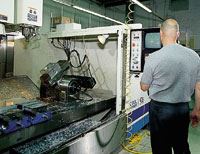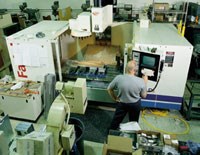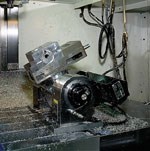Five-Axis Rotary Table Increases Productivity
Five-axis machining tends to conjure up images of pricey VMCs machining aerospace components with complex curves and undercuts. However, manufacturers and commercial job shops are finding a VMC and tilting rotary table with fourth- and fifth-axis motion can significantly reduce setup, handling and cycle times on a variety of commercial components and parts.
Share




Five-axis machining tends to conjure up images of pricey VMCs machining aerospace components with complex curves and undercuts. However, manufacturers and commercial job shops are finding a VMC and tilting rotary table with fourth- and fifth-axis motion can significantly reduce setup, handling and cycle times on a variety of commercial components and parts. These rotary tables can deliver higher accuracy and provide more rigidity for heavy cutting routine operations, such as facing, pocketing, drilling holes and tapping.
The basic concept is to machine parts with only one setup per part. The operator loads the part just once, pushes the cycle start button, and the rotary table moves the part in the required position. This is repeated until all sides/surfaces of the part have been machined and the cycle is finished. Or, the operator can load several parts onto the rotary table and start the machining. As one part is finished, the rotary table brings the next one into the proper position, machining begins, and so on. The advantage is that the VMC can be left unattended for longer periods of time, and less time is spent handling the part.
Quantronix of East Setauket, New York, is one company that began looking at this process to reduce cycle times. Quantronix has been making lasers for industrial and OEM customers since 1967, and was hoping to speed up machining the frames and housings for its lasers.
The company decided to use a Fadal 6030, a large box way VMC with 60-inch X-axis travel, 30-inch Y-axis travel, a 10,000 rpm spindle, 88HS control and a 21-tool changer from Fadal (Chatsworth, California). The 6030 features Cool Power, Fadal’s refrigerant system that maintains the temperature of positioning elements to ±1 degree of the machine’s ambient temperature by recirculating a high performance heat-transfer agent through the spindle nose, around the spindle cartridge and headstock, and through the center of the Y-axis ballscrews. The heat transfer agent flows through the gun-drilled ballscrews and dissipates heat before it causes thermal expansion. This ensures pinpoint positioning and repeatability by minimizing thermal expansion throughout the day.
Whether machining one part at a time, or loading several parts on the same rotary table, the most tangible benefit is the time savings. For example, the machinists at Quantronix load a 6- by 6- by 4-inch aluminum block onto the rotary table and machine the main pocket on the part, which becomes the optical housing. Four different surfaces can be machined with only one setup—the aluminum block is held in place on two sides, so the remaining four sides can be machined—then, machined using the fifth axis starts. The part has angled compound holes with milled surfaces. Drilling these angled holes on the fifth axis eliminates four separate handlings and leads to machining individual housings in 17 minutes, instead of 1 hour. Tool changes are reduced because all of the operations for a tool are completed before the next tool is loaded.
It is important to recognize that each time a part is moved, it is impossible to position it exactly the same as before, which will affect the specified tolerances. But by handling the part once and letting the rotary table rotate the part into position, the part will be positioned within the tolerance capability of the rotary table.
Quantronix machinists discovered that it’s easy to maintain specified tolerances when they don’t have to reposition a part for each side that must be machined.
The optical housings must be parallel within 0.001 inch. This parallelism is achieved with the rotary table, and housings are manufactured with tolerances of 0.0005 inch or better. Accuracy and repeatability on the rotary table are ensured with hardened and precision ground faceplates, pre-loaded bearings and CNC ground-worm shafts.
An important factor in this situation is how the rotary table and VMC work together. Knowing the rotational speed of the table and its torque is essential. The rotary table should also be able to keep up with the tolerances of the VMC. The control needs to accept the rotary table without rewiring. Many of today’s controls can be ordered prewired for rotary tables. For example, the Fadal 88HS Fanuc-compatible control on Quantronix’s 6030 can be ordered so that it can connect to four- and five-axis rotary tables for indexing and true simultaneous machining operations.
Having reduced part cycle times by more than two-thirds, Quantronix reports a revenue increase. “We’ve had phenomenal results with our 6030 and the rotary table,” says Steve Worner, Quantronix’s job shop manager. “Our Fadal 6030 has helped us grow our business beyond what we had expected, and our productivity has shot up.”
Related Content
5 Tips for Running a Profitable Aerospace Shop
Aerospace machining is a demanding and competitive sector of manufacturing, but this shop demonstrates five ways to find aerospace success.
Read MoreHow to Determine the Currently Active Work Offset Number
Determining the currently active work offset number is practical when the program zero point is changing between workpieces in a production run.
Read MoreInside the Premium Machine Shop Making Fasteners
AMPG can’t help but take risks — its management doesn’t know how to run machines. But these risks have enabled it to become a runaway success in its market.
Read More6 Machine Shop Essentials to Stay Competitive
If you want to streamline production and be competitive in the industry, you will need far more than a standard three-axis CNC mill or two-axis CNC lathe and a few measuring tools.
Read MoreRead Next
5 Rules of Thumb for Buying CNC Machine Tools
Use these tips to carefully plan your machine tool purchases and to avoid regretting your decision later.
Read MoreSetting Up the Building Blocks for a Digital Factory
Woodward Inc. spent over a year developing an API to connect machines to its digital factory. Caron Engineering’s MiConnect has cut most of this process while also granting the shop greater access to machine information.
Read MoreRegistration Now Open for the Precision Machining Technology Show (PMTS) 2025
The precision machining industry’s premier event returns to Cleveland, OH, April 1-3.
Read More





































